People living in San Antonio, Texas, don’t need to travel far outside the city to see its wildlife and experience the outdoors! Every year, millions of birds either pass or stay in San Diego, allowing birdwatchers to admire their beauty.
Bird species you’re likely to encounter in San Diego are northern mockingbirds, blue jays, barred owls, great-tailed grackles, wood ducks, turkey vultures, and many others.
Table of Contents
What Are Some Of The Most Popular Birding Spots In San Antonio?
Popular birding spots in San Antonio include Bamberger Nature Park and Leon Creek Greenway in NW San Antonio, Comanche Lookout Park in NE San Antonio, Millers Pond Park in SW San Antonio, Mitchell Lake Audubon Center in southern San Antonio, and many others.
- Leon Creek Greenway and Bamberger Nature Park are both located in northwest San Antonio and are homes to several bird species, including warblers, tanagers, orioles, and flycatchers.
- Comanche Lookout Park is located in NE San Antonio and has a variety of trails and places with great views of the birds living there. In case you visit this historical park, you will find woodpeckers, titmice, thrashers, vireos, goldfinches, and wrens.
- Millers Pond Park is a great birdwatching place to see American coots, red-winged blackbirds, chimney swifts, green-winged teals, American wigeons, ring-billed gulls, and many others.
- On the south side of San Antonio is Mitchell Lake, a 1200-acre complex with a variety of habitats (brushlands, grasslands, ponds, and lakes). You will find swallows, ducks (in winter), warblers, herons, cormorants, pelicans, and others.
San Antonio Birds
1. Northern Mockingbird
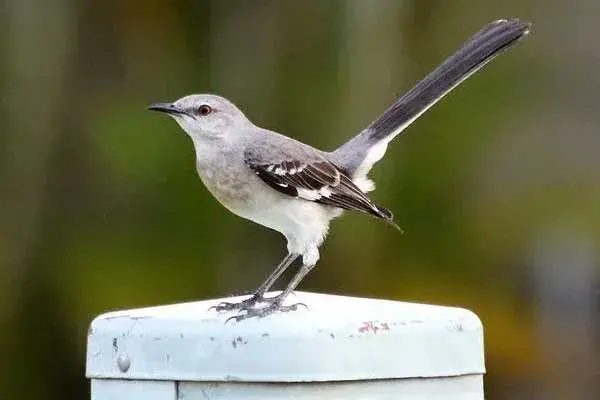
- Scientific Name: Mimus polyglottos
Northern mockingbirds are state birds of Texas. These medium-sized songbirds are widespread and can be seen in San Antonio year-round, in habitats ranging from open country to suburbs.
The Latin name of these birds translates to “many-tongued mimic” and for a reason – they can imitate chirps of up to 35 species and learn over 200 different songs in their lifetime!
Northern mockingbirds can also mimic sounds of rusty hinges, car alarms, cackling hens, and dog barks; they can mimic so well that it’s very hard to tell a difference even with an electronic analysis.
In person, you will easily identify them by their gray plumage with whitish underparts and long tails. In case you see one while it’s flying, notice the large white patches on its black wings and tail. Those white patches help show off during the mating season and flash them when defending territory against some snakes and hawks.
Fun Fact: Northern mockingbirds are territorial birds that can be extremely good at breeding – scientists once recorded a female that managed to lay 27 eggs in a single season!
2. Northern Cardinal

- Scientific Name: Cardinalis cardinalis
Northern cardinals are medium-sized songbirds found in Southeastern Canada, the Eastern USA, Mexico, and parts of Central America.
These beautiful orange-billed birds with stunning head crests are sexually dimorphic. Male northern cardinals are bright red with black throats and faces while the females are mostly brown with reddish wings and tails.
Northern cardinals are very common in San Antonio and can be seen there year-round. Look for them around urban areas such as parks and backyards with large shade trees.
These birds are also known as redbirds and they get their red color from the food they eat – if there are not enough carotenoids in their food, they become brownish.
Fun Fact: Northern cardinals are very territorial and aggressive – these birds will often try to ferociously attack their own reflections in the mirrors and windows.
3. Great-tailed Grackle
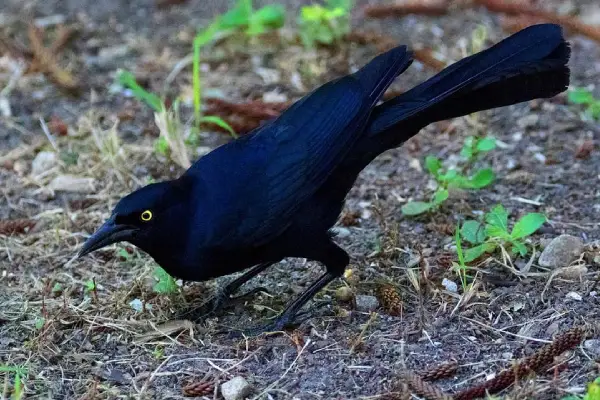
- Scientific Name: Quiscalus mexicanus
Also known as Mexican grackles, great-tailed grackles are medium-sized songbirds native to North and South America.
Males are iridescent black and have a blue sheen on their heads and upperparts; females are brown. Males can be also recognized by their large keel-shaped tails; female tails are not keeled and are smaller than male ones.
One 2010 study discovered that males are a lot glossier than females and that such glossiness correlated positively with tail length.
These black and blue birds are permanent residents of San Antonio and can be seen there year-round. They prefer open areas with scattered trees, especially if there’s a river nearby. They also like urban areas such as parks, lawns, agricultural fields, and even dump sites.
Great-tailed grackles were named for their long tails which are about half their total size. People sometimes call them “devil birds” with tens of thousands of them sitting perched in trees and utility wires, leaving excrement everywhere and making “unholy” screeches.
They are one of 3 grackle species found in Texas.
Fun Fact: These highly intelligent and very social birds roost communally in groups that can include up to 500,000 birds!
4. Blue Jay
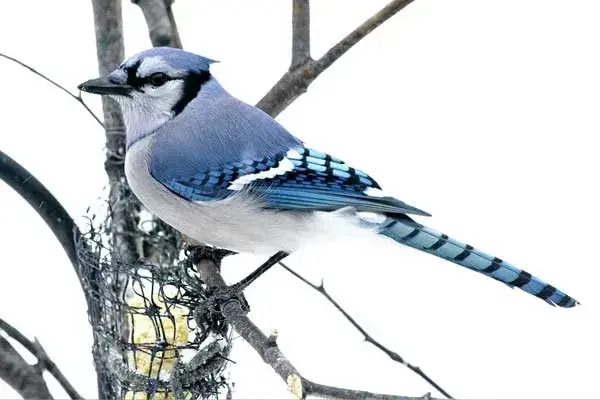
- Scientific Name: Cyanocitta cristata
These large nonmigratory birds can be found throughout the Central and eastern half of Texas.
Blue jays are easy to identify by a mix of black, blue, and white plumage above that is white or light gray underneath. They also have bright blue wings with white spots – males and females look the same.
Blue jays are not state birds in the USA but are mascots of a Major League Baseball team called the Toronto Blue Jays.
These songbirds are highly intelligent and can use tools and imitate the sounds of predators. They might also mimic the sounds of hawks when approaching a feeding site to drive away other birds.
Blue jays are very noisy birds that mate for life and work together to build a nest for their young. When the female is sitting on the eggs, the male will feed and take care of her.
Fun Fact: Blue jays have crests on top of their head that can be used to indicate the birds’ mood – when agitated, the crest goes up and when frightened, the crest goes down.
5. Barn Swallow

- Scientific Name: Hirundo rustica
Barn swallows are the most widespread species of swallow in the world.
In San Antonio, barn swallows can be seen during the summer months. If you visit Mitchell Lake, expect to find barn swallows there.
In early fall, these long-distance migratory birds fly from North American breeding grounds to winter in Central and South America.
Barn swallows can be identified by blue heads and wings, rusty-orange throats and foreheads, and pale orange chests and undersides. They also have long, slender, and deeply forked tails that are a little less prominent in females.
Fun Fact: The legend says that barn swallows stole fire from the gods and gave it to people. Gods became so angry that they threw a firebrand at the bird, burning its middle tail feathers.
Read More: What are some examples of birds with forked tails?
6. Great Blue Heron

- Scientific Name: Ardea herodias
Great blue herons are the largest heron species of San Antonio. They are gray-blue with black plumes on their head, and with long orange beaks.
With a wingspan of up to 6.6 ft, these blue-winged birds are hard to miss. When flying, they will hold their neck in an S-shape with legs trailing behind.
Great blue herons are permanent residents of San Antonio, found year-round in marshes and pond edges. Visit Acequia Park, Mitchel Lake, or Southside Lions Park and you will find great blue herons there.
These wading birds will slowly stalk their prey in shallow waters and strike with lightning speed to catch them with their long and sharp beaks.
Fun Fact: Great blue herons are monogamous only for a single and these enormous blue birds nest in colonies called heronries that can occasionally have more than 500 nests!
7. White-winged Dove
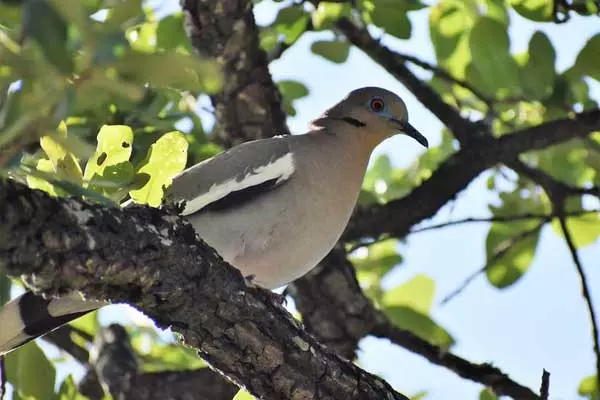
- Scientific Name: Zenaida asiatica
These semi-tropical birds are common in thorny forests, streamside woodlands, and even in deserts.
White-winged doves can be seen during summer in San Antonio. San Antonio Zoo and Brackenridge Park are two great places to find them in the area.
Recognize them by their grayish-brown plumage and a conspicuous white patch on their wings. When perched, the white patch looks like a line along the bottom edge of the wing which is how the species got the name.
These birds can fly 25 or more miles to find water. They are herbivores that feed on seeds, including sunflower, milo, corn, safflower, and some berries from shrubs.
Fun Fact: While migrating, white-winged doves can form flocks with over 4,000 birds.
8. House Finch

- Scientific Name: Haemorhous mexicanus
House finches are widespread small songbirds that have conical bills, short wings, and shallowly notched tails. Males can be identified by their streaky pink-red breasts, eyebrows, foreheads, and rumps, while females are brown above and streaked below; they have no red color.
House finches can be seen throughout the year in San Antonio as they are permanent residents there. They are gregarious and loud birds; look for them around city parks, urban centers, residential backyards, farms, and forest edges in large flocks.
These tiny Texas birds are omnivores and feed on seeds, buds, flower parts, berries, small fruits, and occasionally some small insects. During the non-breeding season, you might also see flocks of house finches around bird feeders.
If you want to attract house finches to your backyard, make sure to add black oil sunflower seeds, millet, and milo.
Fun Fact: The pink-red color of the males comes from the berries and fruits in their diet – females prefer to mate with males that have the brightest faces.
9. Black-bellied Whistling Duck
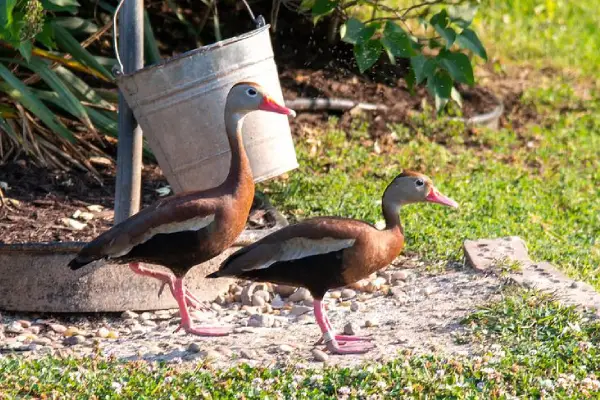
- Scientific Name: Dendrocygna autumnalis
Black-bellied whistling ducks are medium-sized ducks with long necks and legs. Compared to other ducks, black-bellied whistling ducks have extremely elongated legs and necks and slower flights – this is a characteristic of geese and swans and might suggest a close relationship between them.
The pond at the San Antonio Botanical Garden is a great place to find black-bellied whistling ducks as well as the Mitchell Lake Audubon Center. They are permanent residents there.
They are one of the two whistling duck species native to North America; identify them by their chestnut and black plumage, pink legs and beaks, gray faces and necks, bold white wing stripes seen during flight, and white eye-rings.
These extremely social birds will form huge flocks outside of the breeding season, sometimes including hundreds of birds. Black-bellied whistling ducks are monogamous and pair for many years – both parents incubate the eggs and raise the ducklings.
Fun Fact: Female black-bellied whistling ducks might resort to “egg dumping” where they lay their eggs in the nests of other black-bellied whistling ducks for them to raise.
10. Red-shouldered Hawk
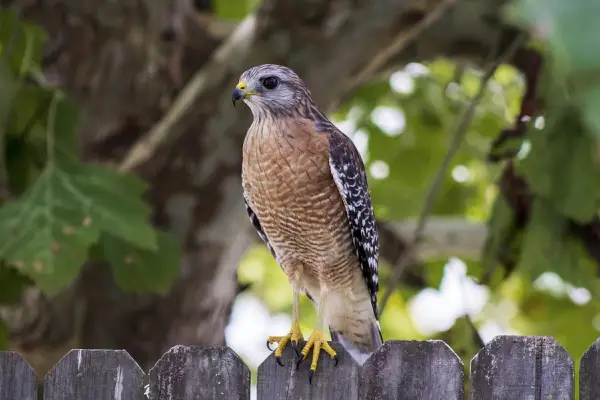
- Scientific Name: Buteo lineatus
One of the most vocal North American hawks, red-shouldered hawks are permanent residents of San Antonio.
They are common around woodlands and forests, often near water, and can be identified by their bold checkered wings and tails, brick-red shoulder patches, and light russet barrings on underparts.
Look for red-shouldered hawks at the San Antonio Zoo, Brackenridge Park, El Dorado Ponds, and Judson Nature Trails.
Red-shouldered hawks will perch on tree branches and utility wires and scan the area. As they spot their prey, they will swoop down and snatch it from the ground or water surface.
These fairly large raptors are carnivores and feed on small mammals, birds, reptiles, amphibians, and crayfish. Red-shouldered hawks are also monogamous and territorial birds.
Fun Fact: Despite both sexes looking similar, females are larger than males.
11. Black-chinned Hummingbird
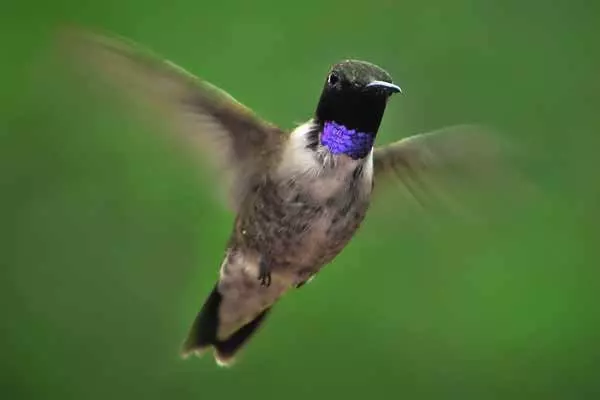
- Scientific Name: Archilochus alexandri
Black-chinned hummingbirds have metallic green upperparts, white underparts, long slender beaks, and dark forked tails. Males have black faces and chins and glossy purple throat bands; females have no throat patches.
Black-chinned hummingbirds are the San Antonio area’s summer residents and will start migrating to their wintering locations around November. The best time to see them in the area would be between March and October.
Black-chinned hummingbirds are common in habitats that include mountains, woodlands, orchards, and meadows. Outside the breeding season, these beautiful birds are mostly solitary, but as part of their courting rituals, males will make broad U-shaped dives 60-100 feet past a perched female.
Fun Fact: During the cold winter periods, black-chinned hummingbirds may consume almost three times their body weight in nectar per day.
12. Painted Bunting

- Scientific Name: Passerina ciris
Often referred to as “nonpareil,” or “unrivaled,” painted buntings are one of the most colorful and beautiful birds of North America.
You will recognize males by their stunning blue head color, red underparts, and green backs. Females usually have bright yellow-green colors.
Painted buntings are incredible blue-headed birds that can be found in San Antonio from spring to fall. Look for them around open woodlands, parks, and brushy fields with scattered trees.
Crownridge Canyon Natural Area, Friedrich Wilderness Park, Olmos Park, Mitchell Lake, Cibolo Nature Center, Guadalupe River State Park, Joshua Springs Park and Preserve, Kreutzberg Canyon Natural Area, and Lost Maples State Natural Area are all great places to find painted buntings in and near San Antonio.
Although painted buntings are common in the area, you might have trouble finding them there since they like to stay in deep brush. The best time to see and hear them would be early in the morning when the males usually sing.
Fun Fact: A group of painted buntings is known as a “mural” and a “palette,” a name that certainly suits their looks!
13. Osprey

- Scientific Name: Pandion haliaetus
Ospreys are large diurnal birds of prey found on every continent, except Antarctica. Due to their small white heads, wide wingspans, and sharp beaks and talons, people sometimes mistake them for bald eagles.
Ospreys are white below, brown above, and overall they are whiter than most birds of prey. They also have M-shaped wings when soaring and white heads with a broad brown stripe through the eyes.
In North America, ospreys breed from Alaska and Newfoundland south to the Gulf Coast and Florida. When winter comes, they move south to winter from the southern parts of the USA to Argentina.
Ospreys are non-breeding residents of San Antonio. Look for ospreys at Calaveras Lake and the ponds of the Castroville Regional Park during winter.
Ospreys are piscivorous and fish makes up 99% of their diet, hence their nickname “fish hawk.”
Fun Fact: During their 20-year-long lifetime, these migratory birds can travel over 160,000 miles!
14. Double-crested Cormorant

- Scientific Name: Phalacrocorax auritus
Double-crested cormorants are large black water birds commonly found around bays, lakes, ponds, canals, and marshes.
Expect to see double-crested cormorants at Mitchell Lake during the winter months.
They are the most widespread cormorant species in North America and can be recognized by their jet-black plumage, small heads, long necks, and thin, strongly hooked orange beaks.
Their most common call is a deep guttural grunt that resembles a pig oinking. When the breeding season starts, males will develop bushy white eyebrows (feathery tufts).
Fun Fact: Double-crested cormorants are excellent swimmers that can dive over 24 feet in depth and stay there for over a minute. However, since they do not have fully waterproof feathers, after hunting, they will stand on the shore with their wings spread to dry.
15. American White Pelican

- Scientific Name: Pelecanus erythrorhynchos
The American white pelican is a large aquatic bird that lives in inland shallow freshwater lakes, wet prairies, and marshes in the summer, and on coastal lagoons in the winter.
It has white plumage and black flight feathers visible only when the wings are spread. American pelican also has a vivid yellow-orange bill, the largest of any other North American waterbird, measuring 10.3–15.2 inches long.
With a wingspan of up to 120 in, American white pelicans are also the largest birds in Texas. They are common on Calaveras and Mitchell Lake during winter in San Antonio.
You will see them arriving in the state from September to late November. Around March, white pelicans will move north to breed in the northern part of the Western USA and Canada.
A small portion of white pelican populations might remain on the Texas coast year-round and breed there.
Fun Fact: A group of pelicans is called a “brief” and a “squadron”.
16. Barred Owl
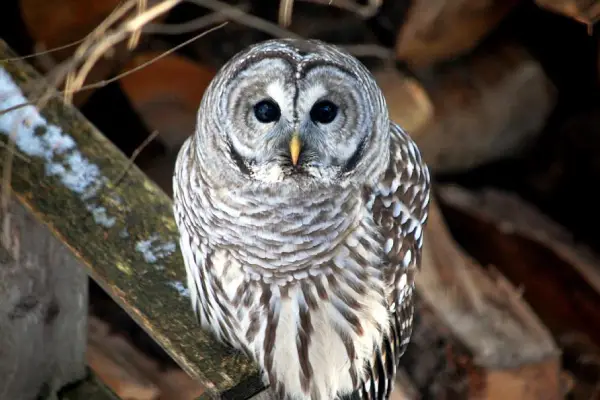
- Scientific Name: Strix varia
Known under several names (northern barred owls, striped owls, or more informally, hoot owls), barred owls are large birds with mottled brown and white plumage.
They can be also identified by their yellow beaks, the absence of ear tufts, and dark eyes. Barred owls are native to eastern North America and are found mostly around woods and swamps where they hunt for insects, small mammals, crayfish, and crabs.
Barred owls nest in Warbler Woods Bird Sanctuary, Helton Nature Park, Judson Nature Trails, and McAllister Park, and can be found there year-round.
Barred owls will nest in tree holes or use abandoned nests of other animals, from red-tailed hawks to squirrels. After they establish nests, barred owls become very territorial and aggressive – they will chase away intruders by hooting aggressively or attacking them with their sharp talons!
Fun Fact: Barred owls will make hoots that sound like “who cooks for you, who cooks for you all” and that can be heard almost half a mile away.
17. Turkey Vulture
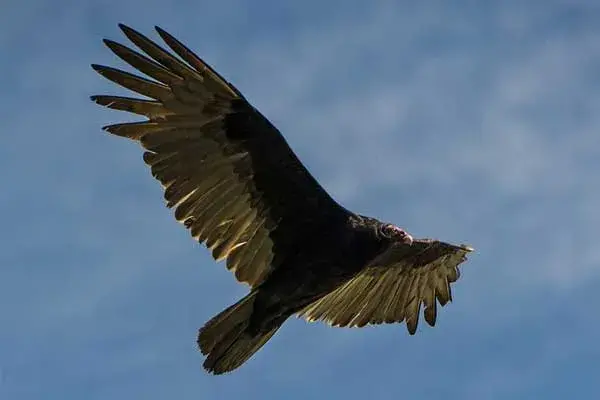
- Scientific Name: Cathartes aura
These big black birds are the most widespread of the New World vultures. Turkey vultures, also known as turkey buzzards, or just buzzards, got named for their resemblance to wild turkeys.
With a wingspan of around 6 feet, black-brown plumage, bare red heads, and white legs, turkey vultures are hard to miss in the sky. Look for their silvery flight feathers that are contrasted with dark wing linings while they fly.
Turkey vultures are permanent residents of San Antonio; the best time to go looking for them is during summer when they are the most common there.
They are one of the largest raptors in the USA, just after the eagles and condors. Some wildlife experts estimate a population of over 18 million turkey vultures in total.
Turkey vultures lack a syrinx (the vocal organ) which makes them voiceless; all they can do is hiss, whine, and grunt. They are very social birds that roost in large community groups with several hundred individuals.
Fun Fact: Turkey vultures can eat and digest carcasses tainted with anthrax, tuberculosis, and rabies, without getting sick due to their extremely strong stomach acids. By doing so, they remove dead animals and prevent the transmission of any diseases they could have carried.
18. Black Vulture

- Scientific Name: Coragyps atratus
In San Antonio, black vultures are just as common as turkey vultures; look for them perching on rails and plucking trash around Brackenridge Park and the nearby San Antonio Zoo.
You will recognize black vultures by their sooty black plumage, bare black heads, and white tips of the wings. People often mistake them for turkey vultures – black vultures are a bit smaller, have shorter wings and tails, and have white color patches on their wings.
Black vultures are monogamous and pairs are believed to mate for life – both the male and female will take turns incubating their eggs. They can be very aggressive which makes other vulture species avoid them.
Fun Fact: To escape from danger, these large San Antonio birds might regurgitate partially digested food to distract the attacker and become lighter before flying away.
19. Yellow-crowned Night-Heron

- Scientific Name: Nyctanassa violacea
Yellow-crowned night herons are stocky wading birds with long necks, large heads, and long heavy black beaks.
They are smooth gray-blue with bold black-and-white head patterns and also have pale yellow crowns on their heads, giving them their common name.
Yellow-crowned night herons can be seen in San Antonio during their breeding season which is typically between March and May. Look for these nocturnal birds at Brackenridge Park, Calaveras Lake, Mitchell Lake, and San Antonio Zoo.
Yellow-crowned night herons tend to roost in trees during the day and feed during the night, mainly on crabs and crayfish.
Fun Fact: Yellow-crowned night herons can be often seen walking slowly or standing still in shallow waters, waiting for their prey to approach before striking with their long beaks.
20. Lesser Goldfinch
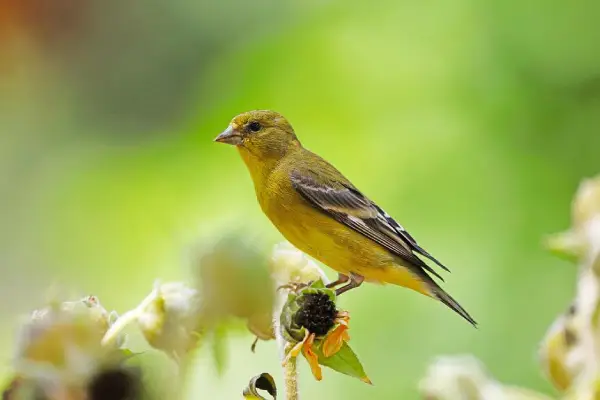
- Scientific Name: Spinus psaltria
Lesser goldfinches are the smallest true finches in Texas and the entire North America. True finches are small birds that belong to the Fringillidae family.
These songbirds are distinctly smaller than American goldfinches (another true finch species) and have long, pointed wings, and short, notched tails.
Male lesser goldfinches are bright yellow below and green or black on their backs. They also have black crowns and white patches on their wings. Females are olive-green below, dull yellow under, and have black wings with two whitish wing bars.
Comanche Lookout Park, Friedrich Wilderness Park, Olmos Park, and Lost Maples State Natural Area, are just a few places where lesser goldfinches are common in SA.
Fun Fact: Lesser goldfinches are social birds that might mix with other songbirds, especially around bird feeders, creating groups of several hundred individuals.
Read More: List of most common songbirds in Texas
21. Wood Duck
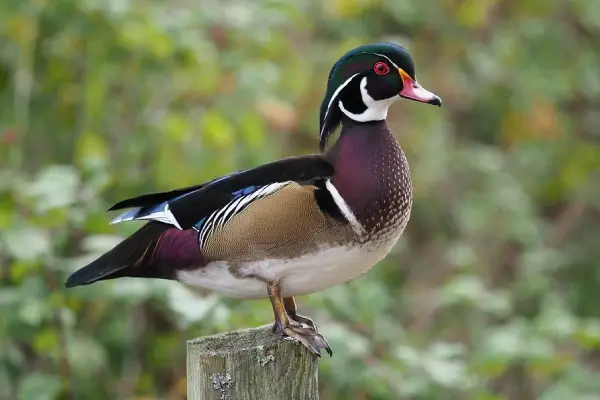
- Scientific Name: Aix sponsa
Wood ducks are also known as Carolina ducks and are one of the most colorful North American waterfowl.
Identify male wood ducks by their multicolored plumage and bright red eyes; females are grayish-brown with white eyerings and blue speculum. Both sexes have crests on their heads.
In San Antonio, you will find wood ducks in Brackenridge Park, Judson Nature Trails, Acequia Park, San Antonio Botanical Garden, and San Antonio Zoo.
They breed in wooded swamps, shallow lakes, marshes, ponds, and creeks on the west coast of the USA, eastern parts of the USA, southern Canada, and on the west coast of Mexico.
Attract wood ducks by putting up a nest box to attract a pair. Just make sure you place it before their breeding season starts in early spring.
Fun Fact: Wood ducks were almost extinct in the early 20th century due to habitat loss and extensive hunting for their meat and plumage, but thanks to strong conservational efforts, the species has recovered.
22. Eastern Bluebird
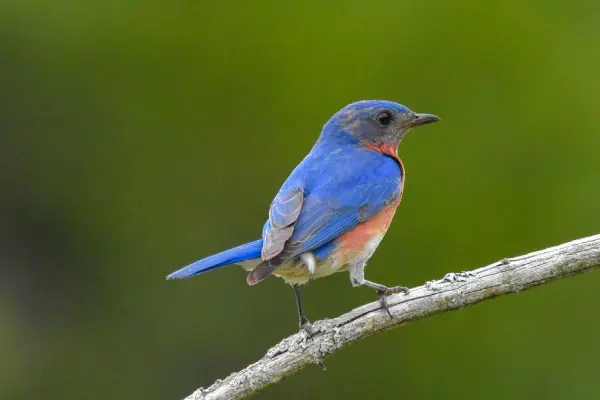
- Scientific Name: Sialia sialis
Eastern bluebirds are the smallest bluebird species in the world. They can weigh less than an ounce and have a wingspan of under 10 inches.
These small North American migratory thrushes are easy to spot by their rounded heads, dark eyes, and alert posture. Male eastern bluebirds have vivid royal blue heads and back plumage and warm red-brown and white breasts. Females are gray above with bluish wings and tails and subdued orange-brown bellies.
They prefer the open country with scattered trees, farms, and roadsides. Some birding sites with eastern bluebirds near San Antonio include the Castroville Regional Park, Guadalupe River State Park, and Helton Nature Park.
Eastern bluebirds are the official birds of Missouri and New York. The bright blue colors of the males which can be easily spotted on wires or open perches, make these small blue birds very popular among birders.
Fun Fact: To attract a female, male bluebirds will sing over 1,000 songs per hour; they sing without opening their beaks wide.
23. Lesser Nighthawk
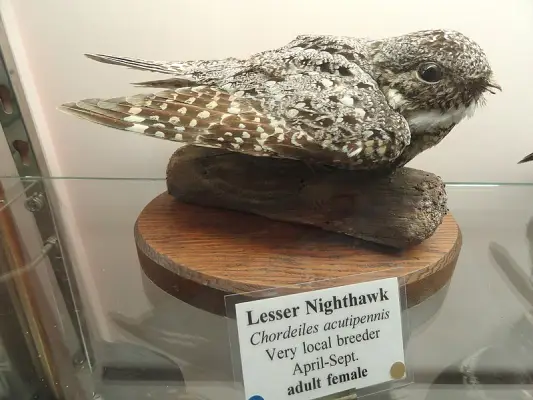
- Scientific Name: Chordeiles acutipennis
These small nighthawks with rounded wings and fairly long notched tails can be often seen flying low over deserts and grasslands. They belong to a group of nightjars, nocturnal birds with long wings that usually nest on the ground.
Lesser nighthawks are camouflaged by their “earthy” colored plumage and only in flight, can you see their distinctive bar across the wingtips. This stripe is white in males and cream-colored in females.
Lesser nighthawks are known for their erratic, bat-like flying technique, graceful loops, and frequent direction changes during flight.
These birds breed across Northern and central California, Nevada, and southwestern Utah south across New Mexico, Arizona, and Texas, and into Mexico. Lesser nighthawks will roost in the Crescent Bend Nature Park and Warbler Woods Bird Sanctuary in the summer.
Fun Fact: Females will not make nests but lay eggs directly on the ground, using their camouflaged bodies to keep the eggs hidden.
24. Dark-eyed Junco
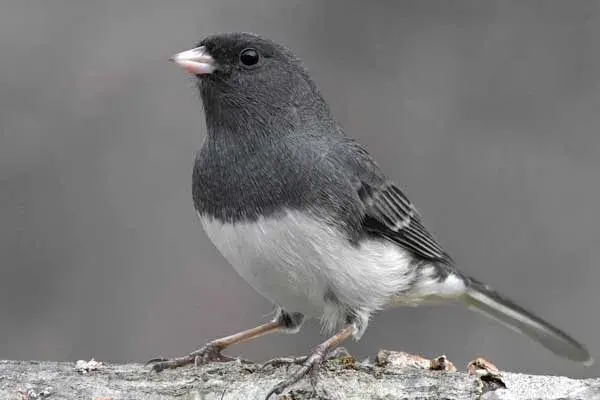
- Scientific Name: Junco hyemalis
Dark-eyed juncos are small songbirds that belong to a group of New World sparrows. There are around 15 recognized subspecies that basically look the same and make taxonomists’ lives a misery.
Dark-eyed juncos can be recognized by their rounded heads, short beaks, and fairly long tails. They also have black plumage, white underbellies, dark heads, and pale beaks.
Dark-eyed juncos are one of the most common birds in North America that can be seen around woodlands, brushy fields, parks, and thickets. They are non-breeding residents of San Antonio and are most common during late fall and winter. Eisenhower Park, located on the northwest side of town, is a great place to spot juncos.
These tiny dark birds often forage while hopping and running on the ground and might even scratch the ground/snow with their feet in pursuit of food.
Fun Fact: Dark-eyed juncos are nicknamed “snowbirds” because they’re commonly sighted during winter.
25. Green Kingfisher
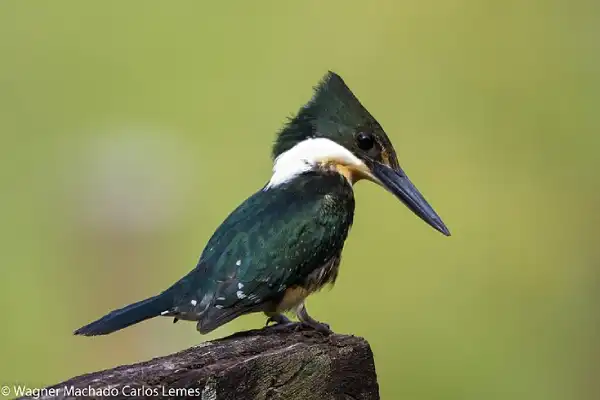
- Scientific Name: Chloroceryle americana
Common in North, Central, and South America, green kingfishers are always found near water. They have dark glossy green plumage, white throats, collars, and spots on their wings. They often keep their tails cocked up and use their long beaks to fish and make their nests on the ground.
Green kingfishers are widespread and are most common in South America (down to Patagonia) and some parts of the USA, in southern Arizona and Texas.
San Antonio’s Medina River Natural Area is a great place to go looking for them. If you go a bit outside of the San Antonio Metro Area, you will also find them at the Castroville Regional Park, Castroville Landmark Inn State Historic Site, Choke Canyon State Park, and Lost Maples State Natural Area.
Green kingfishers have two forward-facing, partially fused toes. These dazzling small green birds will use this toe arrangement called “syndactyl” as a shovel to push the soil out as they build their nest burrows.
Scientists estimate that their global range spans over 6 million square miles. Green kingfishers are carnivores that feed on fish, mostly on minnows and other small fish, and occasionally some insects.
Fun Fact: A group of kingfishers is called a “clique” or a “concentration”.
More Examples Of Birds In San Antonio, TX
- Golden-fronted Woodpecker
- Ladder-backed Woodpecker
- Downy Woodpecker
- Northern Flicker
- Carolina Wren
- Bewick’s Wren
- Marsh Wren
- Green Heron
- Black-crested Titmouse
- Carolina Chickadee
- Pyrrhuloxia
- Curve-billed Thrasher
- Bittern
- White-eyed Vireo
- Wild Turkey
- Spotted Towhee
- Chipping Sparrow
- Field Sparrow
- Blue-gray Gnatcatcher
- Golden-cheeked Warbler
- Black-capped Vireo
- Common Raven
- Verdin
- Western Kingbird
- Scissor-tailed Flycatcher
- Bronzed Cowbird
- Least Grebe
- Crested Caracara
- Black-necked Stilt
- Common Moorhen
- Great-horned Owl
- Eastern Screech-Owl
- Burrowing Owl
- Common Nighthawk
- Common Pauraque
- Chuck-Will’s-Widow
- American Kestrel
- Horned Lark
- Mountain Plover
- Brewer’s Blackbird
Summary
This concludes our list of birds in San Antonio. It included species that can be seen in many parks and areas of the city – feel free to use it as a checklist in case you go birdwatching in SA.